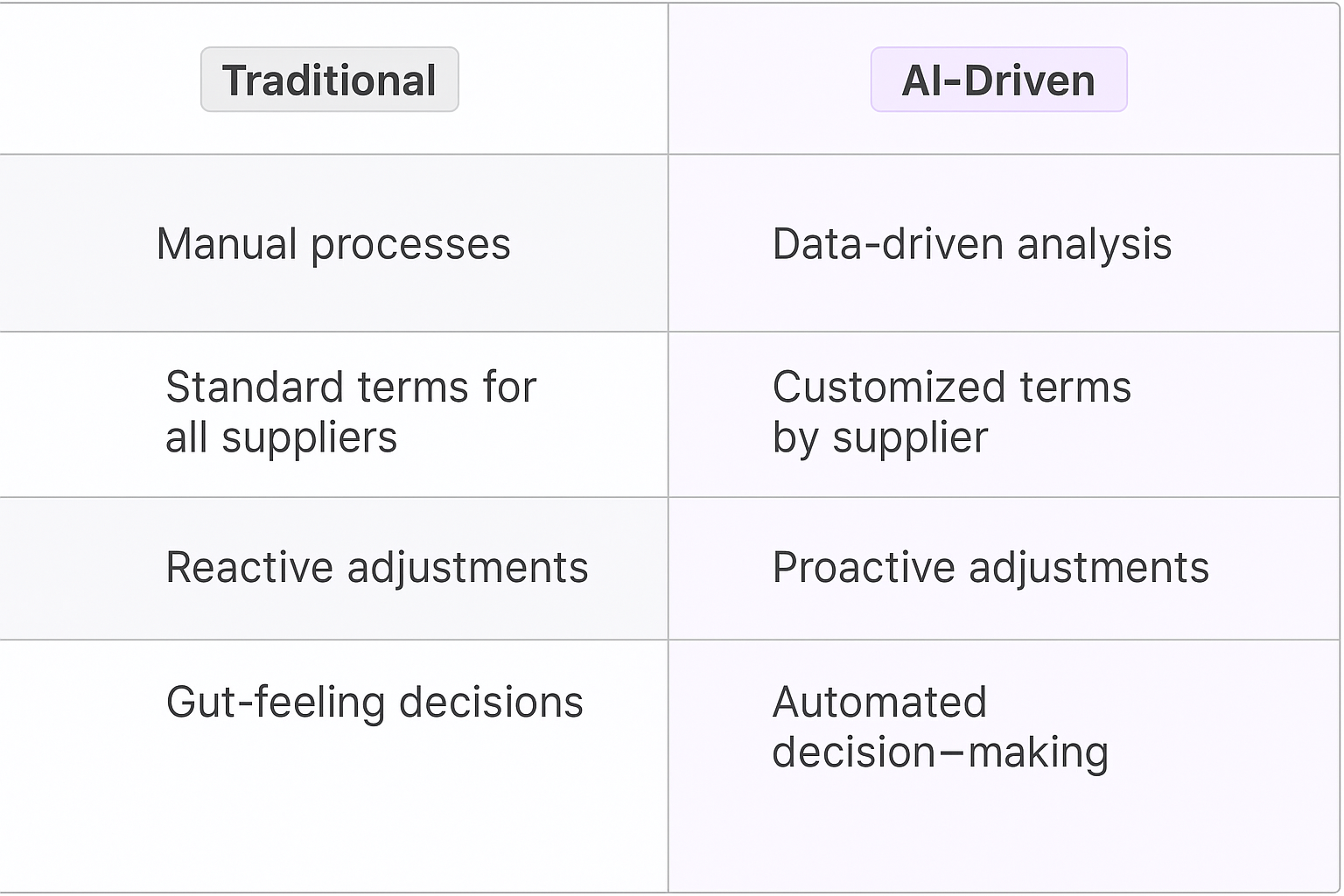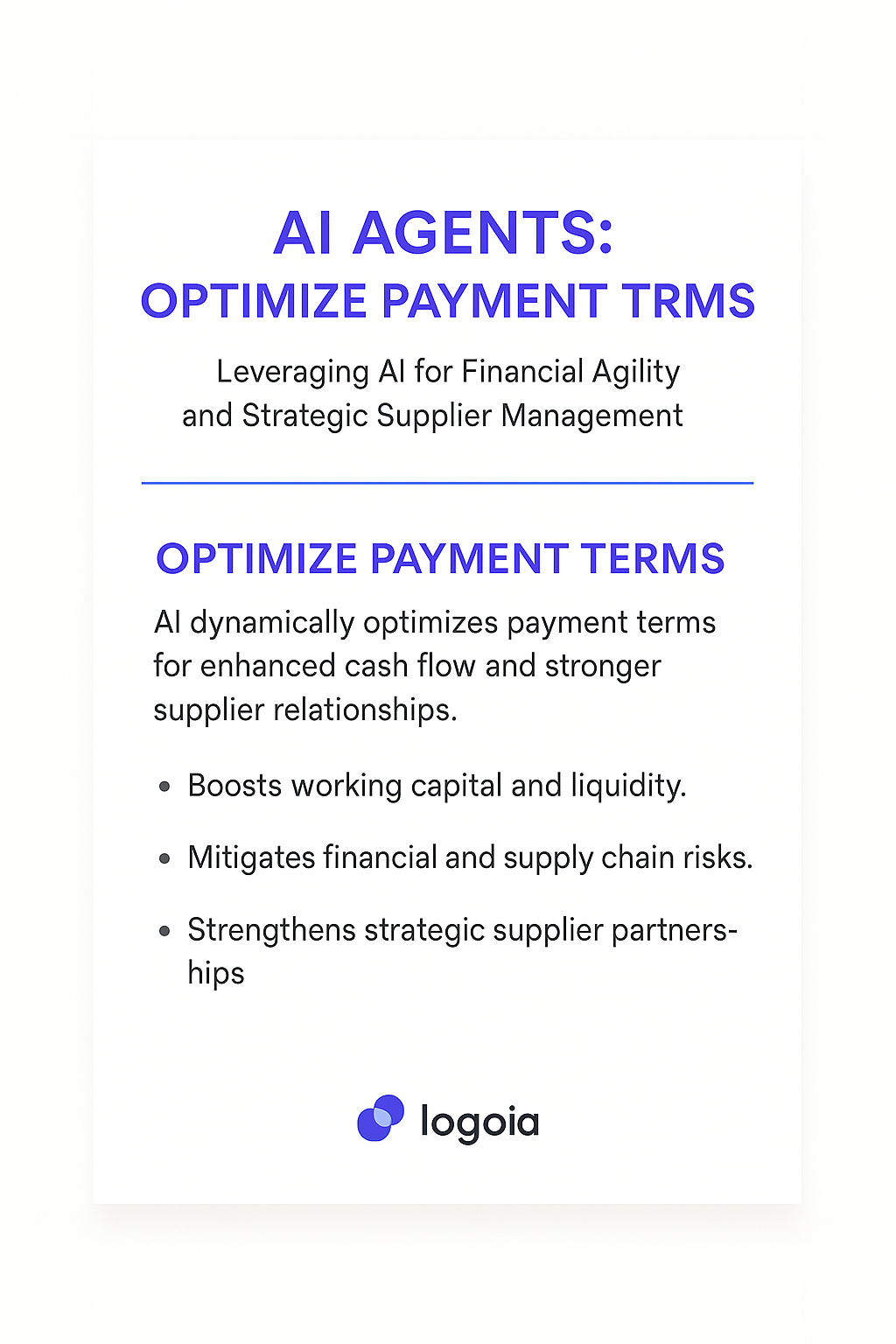Payment Term Optimization AI Agents
The Strategic Process of Payment Term Optimization
Payment Term Optimization is the strategic process of fine-tuning the timing and conditions of payments between a company and its suppliers or customers. It's a delicate balancing act that aims to maximize cash flow efficiency while maintaining strong business relationships. In the past, this was a manual, often intuition-driven process. Now, AI agents are turning it into a data-driven science, allowing companies to squeeze every drop of value from their payment cycles.
Key Features of Payment Term Optimization
- Data-driven decision making: AI agents crunch vast amounts of historical and real-time data to inform payment strategies.
- Predictive modeling: These digital teammates can forecast the impact of different payment scenarios on cash flow and supplier relationships.
- Customization at scale: AI enables tailored payment terms for each supplier or customer, considering their unique characteristics and importance to the business.
- Risk assessment: Continuous monitoring of supplier financial health and market conditions to adjust terms proactively.
- Automated negotiations: Some advanced AI agents can even conduct preliminary negotiations within set parameters, streamlining the process.

Benefits of AI Agents for Payment Term Optimization
What would have been used before AI Agents?
Before AI agents entered the scene, payment term optimization was a manual slog. Finance teams would spend hours poring over spreadsheets, historical data, and supplier contracts. They'd rely on gut feelings and basic heuristics to set payment terms. It was like trying to solve a Rubik's cube blindfolded – possible, but incredibly inefficient and prone to errors.
Companies often defaulted to standard 30, 60, or 90-day terms across the board, missing out on opportunities to optimize cash flow. The process was reactive rather than proactive, with teams scrambling to adjust terms when cash crunches hit or when suppliers started grumbling.
What are the benefits of AI Agents?
Enter AI agents for payment term optimization. These digital teammates are like having a team of finance wizards working 24/7, crunching numbers at superhuman speeds. They're not just fast; they're smart, learning from every interaction and decision to continuously improve their recommendations.
One of the biggest benefits is the ability to tailor payment terms at a granular level. AI agents can analyze each supplier relationship individually, factoring in variables like supplier financial health, order volume, seasonality, and even geopolitical risks. This level of customization was simply not feasible with human-only teams.
AI agents also excel at predictive modeling. They can simulate hundreds of different payment term scenarios in seconds, forecasting the impact on cash flow, supplier relationships, and overall financial health. It's like having a crystal ball for your company's financial future.
Another key advantage is the elimination of bias. Human decision-makers might be influenced by personal relationships with suppliers or past experiences. AI agents, on the other hand, make recommendations based purely on data and predefined objectives, ensuring more consistent and fair terms across the board.
Perhaps most importantly, AI agents enable a shift from reactive to proactive financial management. They can flag potential issues before they become problems, suggesting adjustments to payment terms to head off cash flow crunches or capitalize on favorable market conditions.
The result? Companies using AI agents for payment term optimization are seeing significant improvements in working capital, stronger supplier relationships, and more resilient supply chains. It's not just an incremental improvement – it's a fundamental reimagining of how companies manage their cash flow and supplier relationships.
Potential Use Cases of AI Agents with Payment Term Optimization
Processes
Payment term optimization is a critical yet often overlooked aspect of financial management. AI agents can revolutionize this process, bringing a level of sophistication and efficiency that human analysts simply can't match. These digital teammates can analyze vast amounts of data, identify patterns, and make recommendations that could significantly impact a company's cash flow and financial health.
One key process where AI agents shine is in the analysis of historical payment data. They can sift through years of transactions, identifying trends in customer payment behavior, seasonal fluctuations, and industry-specific patterns. This deep dive into data allows for more accurate forecasting and tailored payment terms that balance customer satisfaction with the company's financial needs.
Another crucial process is risk assessment. AI agents can evaluate the creditworthiness of customers in real-time, factoring in not just traditional credit scores, but also recent payment history, market conditions, and even social media sentiment. This comprehensive approach to risk assessment enables companies to offer more flexible payment terms to low-risk customers while implementing stricter terms for higher-risk accounts.
Tasks
When it comes to specific tasks, AI agents can be game-changers in payment term optimization. They can automatically generate customized payment term proposals for each customer, taking into account their payment history, order volume, and strategic importance to the business. This level of personalization was previously impossible at scale.
AI agents can also continuously monitor and adjust payment terms based on changing conditions. If a customer's financial situation improves, the AI can suggest more favorable terms to strengthen the relationship. Conversely, if red flags appear, it can recommend tightening terms to mitigate risk.
Another valuable task is the simulation of different payment term scenarios. AI agents can run thousands of simulations in seconds, predicting the impact of various payment term strategies on cash flow, customer retention, and overall profitability. This allows finance teams to make data-driven decisions with a clear understanding of potential outcomes.
Lastly, these digital teammates can automate the communication of payment terms to customers. They can draft personalized emails explaining new terms, answer customer queries about payment options, and even negotiate terms within pre-set parameters. This not only saves time but ensures consistent and professional communication across all customer interactions.
The integration of AI agents into payment term optimization processes represents a significant leap forward in financial management. By leveraging these powerful tools, companies can transform a traditionally static and often arbitrary process into a dynamic, data-driven strategy that adapts to the ever-changing business landscape. The result? Improved cash flow, stronger customer relationships, and a more resilient financial position in an increasingly competitive market.

Industry Use Cases: Payment Term Optimization AI Agents
AI agents specializing in payment term optimization are reshaping financial strategies across sectors. These digital teammates aren't just number crunchers; they're sophisticated analysts that can transform how businesses manage cash flow and supplier relationships. Let's dive into some real-world scenarios where these AI agents are making waves:
Manufacturing giants are leveraging these agents to balance their books while maintaining supplier goodwill. Retail behemoths are using them to navigate seasonal cash flow fluctuations. Even in the high-stakes world of construction, where delayed payments can halt entire projects, these AI agents are proving their worth.
But it's not just about big business. Small and medium enterprises, often walking a tightrope between growth and financial stability, are finding these AI agents to be game-changers. They're uncovering opportunities to optimize payment terms that human analysts might miss, giving these businesses a competitive edge.
The beauty of these AI agents lies in their ability to adapt and learn. They're not static tools but evolving partners that grow smarter with each transaction they analyze. This continuous improvement cycle means businesses using these agents are always at the cutting edge of payment term optimization.
Let's explore how different industries are putting these AI agents to work, squeezing every ounce of value from their financial operations.
Retail Revolution: Payment Term Optimization AI in Action
Let's dive into the retail world, where margins are tight and cash flow is king. Picture a mid-sized clothing chain struggling to balance inventory costs with supplier payments. Enter the Payment Term Optimization AI – a digital teammate that's about to flip the script on how this retailer manages its financial relationships.
This AI doesn't just crunch numbers; it's like having a financial savant on your team 24/7. It analyzes historical payment data, supplier relationships, and market trends faster than any human could dream of. But here's where it gets interesting: it starts to identify patterns that even seasoned CFOs might miss.
For instance, it notices that certain suppliers are more flexible with payment terms during off-peak seasons. Armed with this insight, the AI suggests negotiating extended payment terms for large orders placed in these periods. This isn't just about delaying payments; it's about strategically aligning cash outflows with inflows from seasonal sales spikes.
But the AI doesn't stop there. It simulates various payment scenarios, predicting the impact on working capital and supplier relationships. It might recommend early payments to key suppliers in exchange for discounts, effectively turning accounts payable into a profit center.
The result? Our clothing retailer sees a 15% improvement in working capital within the first quarter. They're able to invest more in trending inventory, outpacing competitors who are still stuck in traditional payment cycles.
This isn't just optimization; it's a fundamental shift in how retailers can approach their supply chain finances. It's turning a back-office function into a strategic advantage. And in retail, where margins can make or break a business, that's not just an improvement – it's a game-changer.
Construction Industry: Building Financial Foundations with AI
The construction industry is ripe for disruption, and Payment Term Optimization AI is the wrecking ball that's about to reshape how builders manage their cash flow. Let's zoom in on a mid-sized construction firm that's been grappling with the classic problem of long payment cycles and unpredictable project timelines.
This AI isn't just a number cruncher; it's like having a financial architect who understands the unique rhythms of construction projects. It dives deep into the firm's historical data, analyzing everything from subcontractor payment patterns to material delivery schedules. But here's where it gets interesting: it starts to uncover hidden financial inefficiencies that have been lurking in the shadows of half-built skyscrapers.
For example, the AI identifies that certain subcontractors consistently deliver ahead of schedule during summer months. It suggests negotiating more favorable payment terms with these high-performers, aligning payments with actual work completion rather than arbitrary dates. This isn't just pushing paper around; it's about creating a financial structure as solid as the buildings they're constructing.
But the AI's blueprint goes further. It simulates various payment scenarios across multiple ongoing projects, optimizing cash flow across the entire portfolio. It might recommend accelerating payments to key suppliers to secure bulk discounts on materials, effectively turning the accounts payable department into a cost-saving powerhouse.
The results are concrete: within six months, the construction firm sees a 20% reduction in days payable outstanding without straining supplier relationships. They're able to take on larger projects and weather unexpected delays without resorting to expensive bridge financing.
This AI-driven approach isn't just tweaking the numbers; it's fundamentally reengineering how construction firms approach project finances. In an industry where cash flow can make or break a project, this AI is laying the foundation for a new era of financial agility and project success.

Considerations
Technical Challenges
Implementing a Payment Term Optimization AI Agent isn't a walk in the park. It's more like trying to solve a Rubik's cube blindfolded while riding a unicycle. The first major hurdle? Data integration. You're dealing with a mishmash of financial systems, ERP platforms, and legacy databases that often speak different languages. It's like trying to host a dinner party where all your guests are from different planets.
Then there's the algorithm complexity. Optimizing payment terms isn't just about crunching numbers; it's about predicting human behavior, market fluctuations, and economic trends. You're essentially asking your AI to be part accountant, part fortune teller, and part behavioral psychologist. It's a tall order, even for the most sophisticated machine learning models.
Let's not forget about scalability. As your business grows, your AI needs to keep up. It's like trying to upgrade the engine of a car while it's speeding down the highway. You need an architecture that can handle increasing data volumes and complexity without breaking a sweat or, more importantly, breaking the bank.
Operational Challenges
On the operational side, things get even trickier. First up: change management. Introducing an AI to optimize payment terms is like telling your finance team you're replacing their trusty calculator with a quantum computer. There's going to be resistance, confusion, and a steep learning curve.
Then there's the trust factor. How do you convince your CFO that an AI can make better decisions about payment terms than seasoned professionals with decades of experience? It's like trying to sell ice to Eskimos, except the ice is made of algorithms and the Eskimos have MBAs.
Compliance and risk management add another layer of complexity. Your AI needs to navigate a labyrinth of financial regulations, international trade laws, and corporate policies. One misstep, and you're not just facing a financial hit; you're in legal hot water.
Lastly, there's the ongoing maintenance and optimization. An AI isn't a set-it-and-forget-it solution. It needs constant feeding with new data, regular check-ups to ensure it's performing as expected, and occasional overhauls to keep up with changing business needs. It's like having a high-maintenance pet that eats data and poops insights.
Implementing a Payment Term Optimization AI Agent is a complex endeavor that requires a delicate balance of technical prowess, change management skills, and a good dose of patience. But for those who can navigate these challenges, the potential rewards in terms of improved cash flow and financial efficiency are substantial. It's not for the faint of heart, but then again, what worthwhile innovation ever is?
Transforming Financial Management with AI-Driven Payment Optimization
Payment Term Optimization AI Agents are more than just a technological upgrade; they're a paradigm shift in financial management. By harnessing the power of machine learning and big data, these digital teammates are enabling businesses to navigate the complex world of payment terms with unprecedented precision and agility. They're turning what was once a reactive, often arbitrary process into a strategic lever for financial performance.
But the real magic lies in how these AI agents learn and adapt. Each transaction, each negotiation, each market shift becomes a data point that refines their models and improves their recommendations. It's like having a financial strategist that never sleeps, never takes a vacation, and gets smarter by the minute.
As we look to the future, the companies that embrace these AI-driven approaches to payment term optimization will likely find themselves with a significant competitive advantage. They'll be able to weather economic storms more easily, seize growth opportunities more quickly, and build stronger, more resilient supplier networks.
The journey of implementing these AI agents may be complex, fraught with technical and operational challenges. But for those who successfully navigate these hurdles, the rewards are substantial. It's not just about improving a single financial metric; it's about fundamentally transforming how businesses manage their cash flow and financial relationships in an increasingly dynamic global economy.











